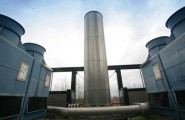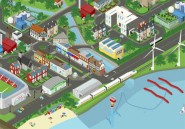Decentralised
energy
The city centres of
tomorrow’s networked world will produce power and heat as well as
consume it. The roofs and facades of public buildings are ideal for
harvesting solar energy. Efficient energy use will become the
standard for all buildings. We will have a diversity of energy
sources that are well suited to the needs of the area and in some
cases, particularly in developing countries, independent from the
national network.
This model of
decentralised energy generation, where energy is produced close to
the point it is consumed, will provide big energy savings. One of the
key technologies that can be used is combined heat and power (CHP)
stations. These stations capture the heat produced as a by-product of
electricity generation and use it to heat buildings and to power
industrial processes, instead of wasting it up cooling towers like
conventional power stations.
We also lose between
three and five per cent of the electricity we generate when it is
transmitted across long distances.
Decentralised energy is
scalable and flexible. It can range from a tiny CHP plant in a
supermarket or a single wind turbine to enormous industrial plants like Immingham,
Europe’s largest, or wind
farms like Thanet off the Kent
coast.
Decentralised energy also has a key role to play bringing
clean energy to about a quarter of the people on the planet who are
living without electricity. Renewable energy can
easily be harnessed on a small scale, at or near the place where
energy is needed. This approach to energy production means that the
local system can be designed based on what resources are available
locally and what is needed by the people.
It can also be
empowering for people by providing them the opportunity to operate
and govern their own energy services and stimulating the local
economy.
Combined Heat and
Power

A combined heat and power plant in Amsterdam
CHP is the heart of an efficient, decentralised energy system. It's the
most efficient way possible to burn fuel because so little energy is
lost as waste heat. That's how CHP plants in Denmark can reach up to
95 per cent efficiencies.
Because the heat needs
to be captured and piped around the local district, CHP plants are
usually sited in the towns and cities where the electricity and heat
will be used. This makes it more efficient for electricity generation
as well as heat; very little energy is lost in transmission.
CHP has enormous
potential in Britain, and when combined with improved efficiencies
in the home
(proper insulation say, and minimum efficiency standards for
appliances), would practically eliminate the enormous wastage inherent in our
current system.
CHP has a crucial role
to play in the transition from a fossil-fuelled energy system to one
based on cleaner, greener fuels. CHP plants can run on a variety of
fuels, which means that the fuel mix can include fossil fuels like
natural gas but, as more cleaner fuels like biogas and biomass become more available, they can switch to those.
Combined heat and power
plants can be tailored to fit local needs, allowing us to take
advantage of local energy sources. But to make the most of what CHP
and decentralised energy can offer, we need to make changes to the
way power is used and consumed.
We need a smart grid.
Smart grids
A smart grid is an
electricity network which intelligently integrates the actions of all
users connected to it - energy generators, consumers and those that do
both - in order to efficiently deliver a sustainable, efficient and
secure supply of energy.
In traditional power
grids, power generation follows how much businesses and people want.
But in the near future, technology will allow power consumption to
respond to how much electricity is available, with things that aren’t
time-critical shifting to periods when more power is available. Using
smart
meters,
smart appliances and energy monitors in our homes, smart grid will
allow us to:
immediately see what
we are using online. We can then take advantage of this information to charge our electric cars at night drawing on cheap wind
power, for example, or to programme new ‘smart’ appliances like
washing machines that can operate at times when prices are low.
integrate
clean
energy technologies
like wind power where power generation is variable
create
our own electricity (such as from solar panels on our roofs) and
sell any surplus back to the grid – thereby encouraging more
decentralisation.
Before he was elected,
Prime Minister David Cameron outlined plans for a £1bn investment in
an energy smart grid, and to install a smart meter in every home.
This pledge was again confirmed in the coalition
agreement published in May 2010. We’ll be working to hold him to this
promise.
See
a decentralised energy system in action

EfficienCity - a model of a decentralised energy system.
We wanted to show how
a decentralised energy system could be implemented in the UK so we created a climate-friendly virtual
town -
EfficienCity.
At the heart of EfficienCity are some exciting technologies – all
of which are already being applied or tested in the real world:
- combined heat and
power
- a
variety of fuel sources
- renewable
energy
- a
smart electricity grid
- smart
appliances
Smart appliances
Imagine if your washing
machine could turn itself on or off to take advantage of off-peak
electricity prices. We’re on the verge of a technological leap into
smart appliances which do just that.
They use 'dynamic
demand'
technology to monitor second-by-second changes to the national grid.
This allows them to switch on when demand is low and electricity is
cheap, and to turn themselves off when spikes in demand threaten to
overwhelm the network.
The potential savings
in energy use and carbon emissions are enormous. If all homes had
smart fridges, for example, Britain’s annual CO2 output would fall
by two million tonnes, the equivalent of taking 700,000 cars off the
road or closing a large coal-fired power station.
Energy companies are
already conducting trials with this technology, and plan to offer
grants and cheaper tariffs to encourage all households to switch to
smart appliances.
The benefits of
successful dynamic demand control could be considerable:
- A more efficient and
stable power grid
- Significantly
reduced CO2 emissions from power generation
- Removing
an important barrier to a using higher proportions of renewable
energy
- A
reduction in the cost of renewable energy
- Lower
energy bills for all of us.
See a 60-second
explanation here.
Electric cars
Transforming our
transport system into a zero-emission transport system is also
crucial if we’re going to reduce our dependency on fossil fuels.
The good news is that the technologies which can accomplish this are
starting to become available.
A new generation of
electric vehicles are about to hit our roads - cars and vans that
look, drive and feel very similar to the oil-powered models they
replace, except that they are practically silent and emission-free at
point of use.
Major manufacturers are
now introducing cars that can travel over 100 miles on a single
charge, and recharge in six hours, making them more useable than ever
before. Costs are rapidly becoming comparable with conventional cars
– and this is just the start.
But it’s only half of
the equation - because emissions savings from switching to electric
cars will depend on two crucial factors: how the electricity that
powers them is generated; and how successful power companies are in
managing what will almost certainly be an increase in demand for
electricity.
The clean energy
technologies already exist which can provide the necessary power –
but we need to start ramping up production to meet the surge in
demand, otherwise we end up running electric cars on electricity
produced from fossil fuels, and make no CO2 savings at all.
Managing that demand
can be achieved using the 'dynamic demand' technology already
discussed. When fitted to vehicles, this will allow them to recharge
intelligently, adjusting the power they use to variations in the
demands being made on the grid.




